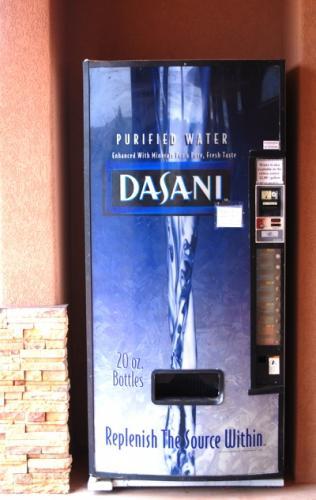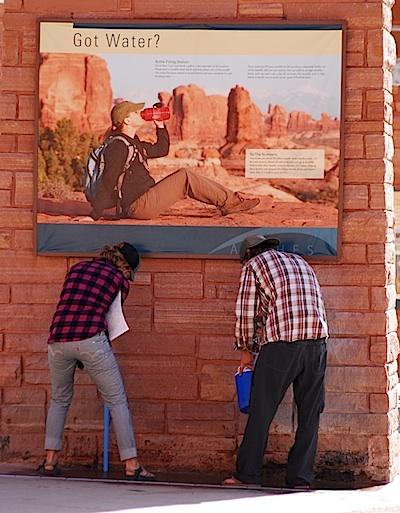
Disposable water bottle sales likely will return to many national parks following the announcement Wednesday that the National Park Service ban on the bottles was rescinded/Kurt Repanshek file photo
Editor'snote: This updates to include comment from the International Bottled Water Association, clarifies that the ban was against the sale of disposable bottles.
The Trump administration announced Wednesday an end to a controversial ban on the sale of disposable water bottles in the National Park System, a move applauded by the bottled water industry but no doubt disappointing to reusable bottle makers and organizations trying to reduce plastic waste.
In a release not immediately distributed directly to media outlets but quietly posted on its press release website, the National Park Service said its decision to overturn the ban was part of its "commitment to providing a safe and world-class visitor experience."
The 2011 policy, which encouraged national parks to eliminate the sale of disposable water bottles, has been rescinded to expand hydration options for recreationalists, hikers, and other visitors to national parks. The ban removed the healthiest beverage choice at a variety of parks while still allowing sales of bottled sweetened drinks. The change in policy comes after a review of the policy’s aims and impact in close consultation with Department of the Interior leadership.
“While we will continue to encourage the use of free water bottle filling stations as appropriate, ultimately it should be up to our visitors to decide how best to keep themselves and their families hydrated during a visit to a national park, particularly during hot summer visitation periods,” said acting Park Service Director Michael T. Reynolds.
The battle over bottled water dates to December 2011, when then-National Park Service Director Jon Jarvis gave park superintendents the option to impose a ban in a move to reduce litter in the parks and waste in landfills. Since then, nearly two dozen parks have banned their sale, and installed water stations for visitors to refill their reusable bottles and hydration packs.
But the move was never popular with the bottled water industry, and their lobbyists found allies in Congress to push back against the Park Service ban. Indeed, even before former Park Service Director Jarvis agreed to a ban, the Park Service's commitment to a green environment was partially derailed when Coca Cola in November 2011 raised concerns over plans to ban disposable water bottles at Grand Canyon National Park with the National Park Foundation and Director Jarvis, who initially blocked the ban.

Despite the ban's removal, water-filling stations likely will remain in national parks/Kurt Repanshek file photo
In coming around to agree to a ban of disposable plastic water bottles, then-Director Jarvis cited the Park Service's Green Parks Plan, which had a goal of reducing waste in the parks, in part by offering water bottle refilling stations in at least 75 percent of park visitor centers by 2016, the year the agency marks its centennial. (Note: The NPS failed to reach that goal.)
Since that 2011 directive went out, there have been occasional moves to force the Park Service to lift the ban.
Early in 2013 the bottled water industry pushed back against the ban, saying it would encourage visitors to turn to unhealthy alternatives to quench their thirsts. According to the International Bottled Water Association, research shows that in the absence of bottled water products, "63 percent of people will choose soda or another sugared drink – not tap water."
In 2015, the House of Representatives approved an amendment to overturn the ban, but then the bill it was attached to, the House Interior Appropriations bill, was pulled back due to a fight over whether Confederate flags could be displayed at national cemeteries. The Bottled Water Association at the time said the House's move to overturn the ban "is a vote for public health and safety."
Then last year the funding bill for the Interior Department drafted by the House contained language that would have blocked the Park Service from using its budget to enforce the bottle ban.
Shortly after the Park Service announced the death of the ban the International Bottled Water Association released comments approving the move.
“The International Bottled Water Association applauds this action, which recognizes the importance of making safe, healthy, convenient bottled water available to the millions of people from around the world who want to stay well-hydrated while visiting national parks,” said IBWA Vice President of Communications Jill Culora. “Consumption of water in all forms – tap, filtered, and bottled – should always be encouraged.”
Currently only 23 of the 417 National Park Service sites have implemented the policy, the Park Service said Wednesday. The revocation of the memorandum, which was put in place on December 14, 2011, is effective immediately. Parks will continue to promote the recycling of disposable plastic water bottles and many parks have already worked with partners to provide free potable water in bottle filling stations located at visitor centers and near trailheads, the agency said.



Comments
y-p-w - you are correct. And from a practical standpoint, the ban had vitually no impact on the amount of plastic water bottle waste which in itself is not a problem. Once again, a regulation that had no material benefit but caused significant inconvienence and potentially even life.
Oh well, reason has left the building. Parks still have the opportunity to educate people about the wastefulness and lazyness of buying bottled water, but less effectively.
"the amount of plastic water bottle waste which in itself is not a problem". You see, folks, the incredibly inane things that can be dropped into a sentence without a blink once avarice has carried the day?
More baseless accusations from Rick. Since I have absolutely no financial interest in plastic water bottles, the suggestion that "avarice" is driving my opinion is totally unfounded.
So tell us Rick, what exactly is the "problem" with plastic water bottle waste?
The move by the National Parks comes three weeks after the Senate confirmation of David Bernhardt as deputy interior secretary. Bernhardt, according to the Washington Post, served as a lobbyist with the law firm Brownstein Hyatt Farber Schreck, which has represented Nestle Water, one of the largest water bottlers in the United States and the distributor of the Deer Park brand.
Bernhardt is not a member of Brownstein Hyatt now and did not work the Nestle account. In fact he worked on several public water company accounts.
You personify avarice. I don't care about the specifics of your stock porfolio.
Just because of including one disclaimer sentence about hate groups, please don't think that overrules the entire body of work you've done to show sympathy for the hate groups. Go away.
You want to know what's wrong with plastic waste? click the link:
http://www.bbc.com/news/science-environment-40654915